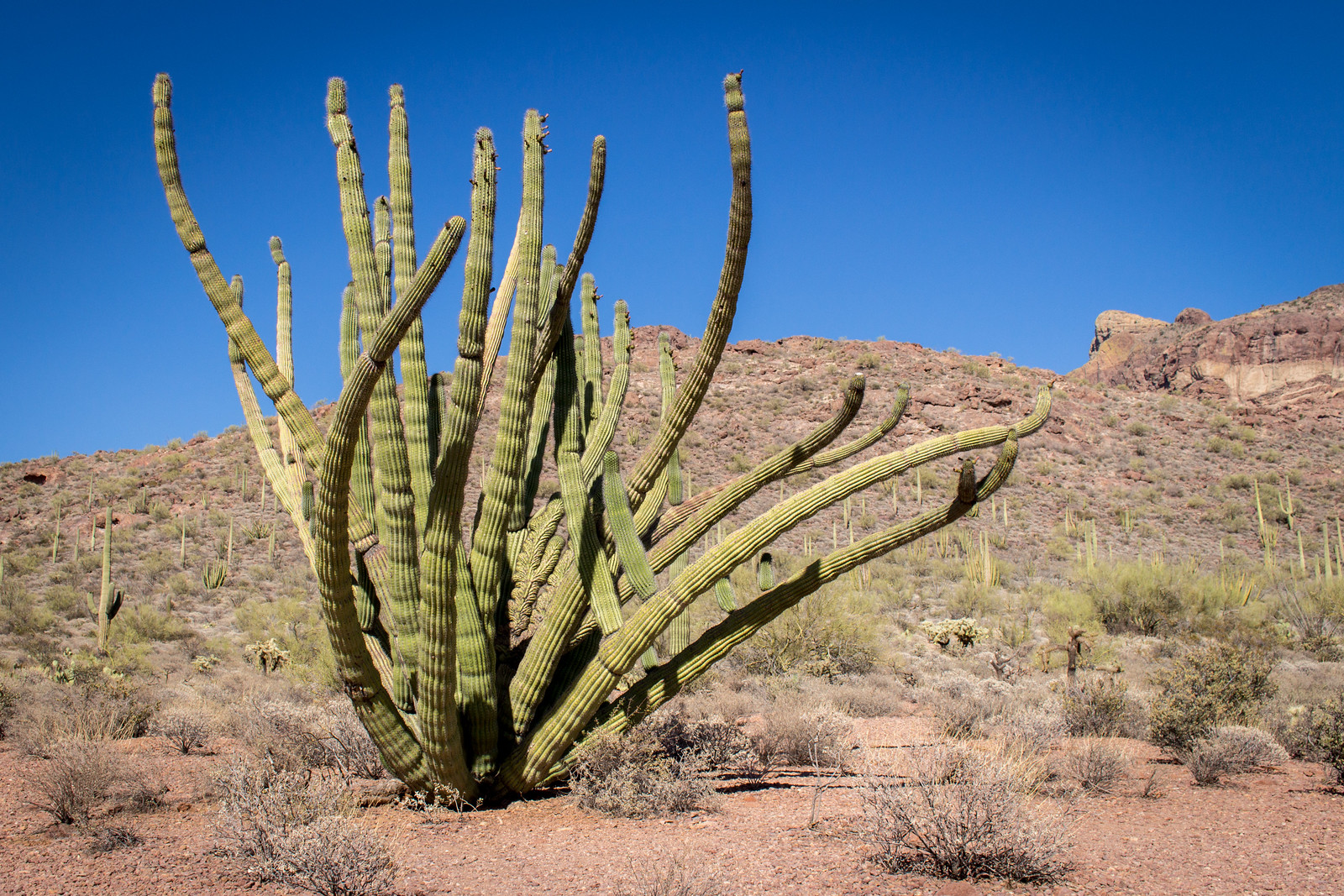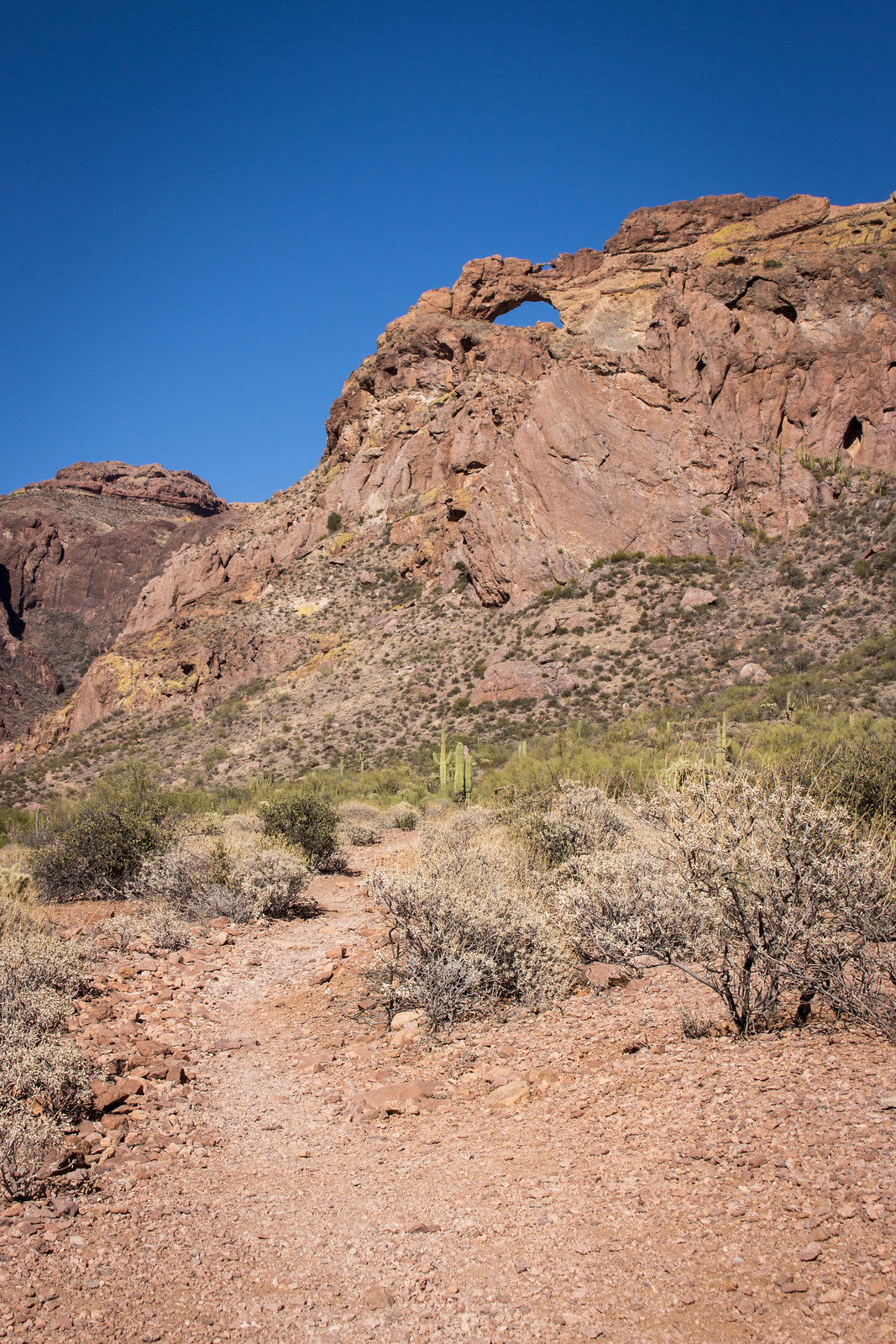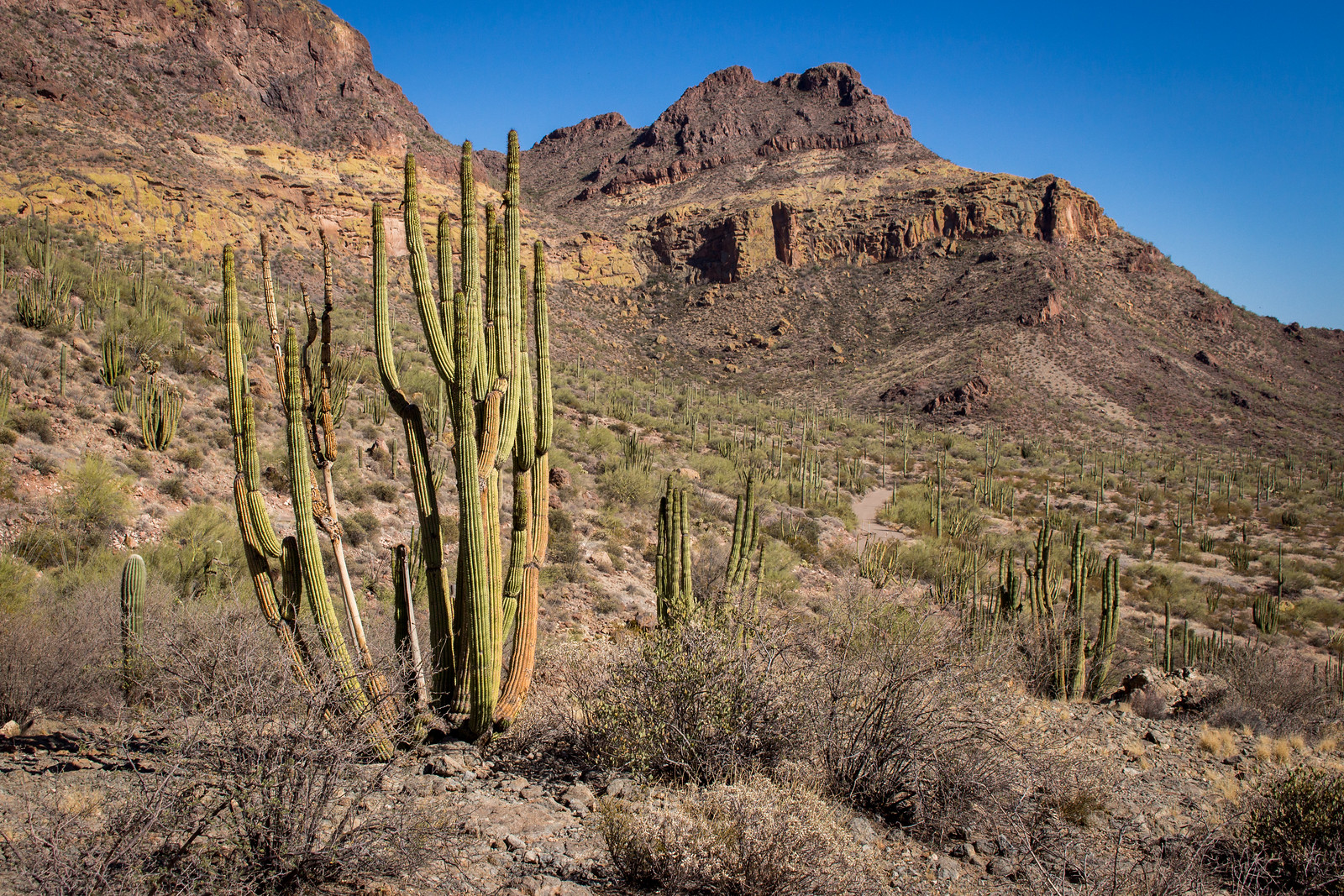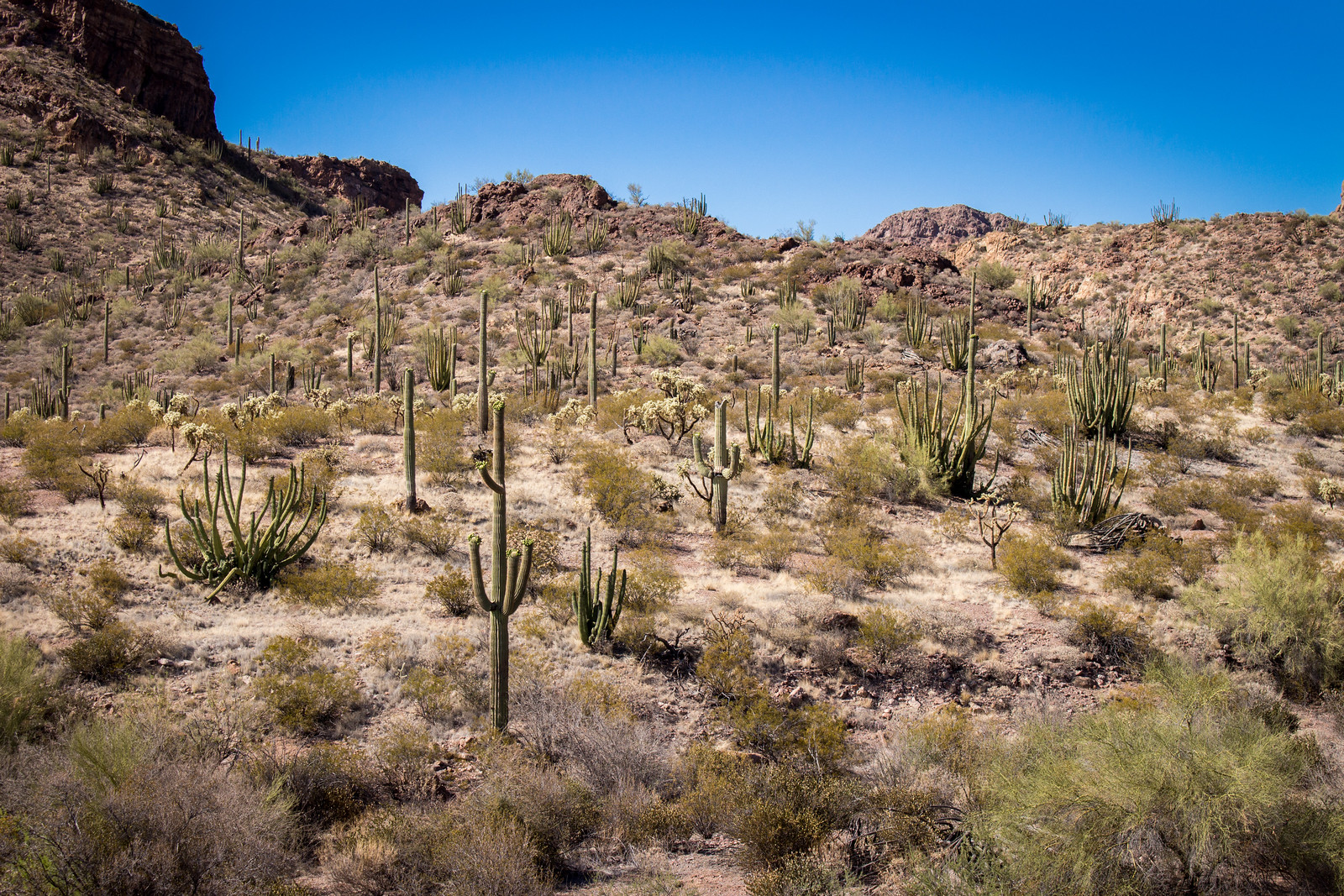Organ Pipe Cactus National Monument: A Precious Slice of the Sonoran Desert
I was hunting for arches. No, not Utah’s Arches National Park, crawling with tourists, but a tiny two-paned window high up in the hills of one of Arizona’s remotest national monuments. It was a double arch—one stacked on top of the other—found in the aptly named Arch Canyon, that drew me one warm May afternoon.
Sure, I could see the striking splotches of blue sky shining through the rusty earth from the comfort of my air-conditioned car, but I wanted more; I wanted to see the arch from the other side, and to see it much closer up. So, I parked my car at an empty trailhead that began on an unpaved road nine miles deep from the highway and set off with my camera, some water, and perhaps a little naïveté.
Whimsical green columns sprouted up all around me, some from a central trunk and others from the desert floor all bushy like. Globular chollas vied for space in the neighborhood with creosote trees, but what was most striking was the lack of any noise at all. Hardly a breeze was blowing, and this corner of Arizona desert was so far from most flight paths that I could tell whenever a little lizard would scurry beneath the brittlebush or a bird would flutter from one spiky cholla arm to another.
As I got closer to the arch, it grew harder and harder to make out until it finally disappeared as I reached the end of the developed hiking trail. I disregarded the “CAUTION” sign with all the confidence of a green hiker with barely one month of life in the Southwest under his belt.
The cactus stayed behind on the valley floor as the mountains tightened in around me, and the pleasant gravel of the maintained trail gave way to a slippery (and steep) rock face. I’m sure the arches are just a little further, I thought. I stopped to drink some water and noticed the shadows growing longer. I hadn’t seen any other folks the entire hike, and the land just beyond the ridgeline belonged to the Tohono O’odham Nation, a Native American tribe whose territory stretches into northern Mexico. I hope I don’t accidentally trespass into the reservation.
I kept climbing further up as the trail got slippier and steeper, but I still couldn’t catch sight of the double arch. I decided to give up and turn around, but then my feet caught on some gravel and I started to slide, taking a tumble on my way down. I caught myself before I could get seriously injured, but my fancy camera lens had slammed into the ground when I fell. It still worked in the moment, but it would eventually fail completely a few months later.
Immediately, I realized how dangerous a situation I was in: hiking alone, off the developed trail, into a canyon, in a little-visited national monument, with zero cellphone service, as the sun was beginning to set. Adrenaline jolted through my chest while my anxiety levels exploded. After carefully crawling back down the canyon, I jogged back to my car as fast as I could without running into cactus.
I failed to find that double arch, but it was nice to be back on the desert floor. After all, I was surrounded by organ pipe cactuses in this national monument of the same name.
Unlike its cousin the saguaro, which starts its life as a single “trunk” from which additional arms branch out, the organ pipe is more bushy, with multiple arms all growing simultaneously toward heaven like the pipes of a church organ.
The organ pipe is also a night owl, drawing visitors like lesser long-nosed bats to pollinate its flowers. (The saguaro keeps its flashy blossoms open throughout June days and nights.) As a baby cactus, the saguaro needs a “nurse tree” to provide shade before maturing, but the organ pipe needs no such protection; it thrives on south-facing hillsides where it can soak up the intense desert sun.
The organ pipe cactus reminds us humans that we are small, but not just because its “pipes” extend 10–20 feet tall. This cactus can live in the sunblasted desert for 150 years or more at a time…which means a lot of the organ pipes you see in this national monument today have probably been around as long as—or longer—than the U.S.–Mexico border a few miles south.
Here, the stands of saguaro cactuses are so dense that they almost look like a forest from far away. If “Saguaro NationalMonument Park” weren’t already taken by another park two-and-a-half hours east of here, it’d be a fitting name for this monument. Let your imagination run wild, finding shapes or humanoid figures in the plants, or just delight in a rare crested saguaro, if you can find one.
The Sonoran Desert is such an interesting place not because it’s uniform—no “sand, sand, and more sand” here—but because it’s so diverse. Come to this monument to take it all in. Appreciate the creosote flats where the desert “smells like rain” and look (but don’t touch!) at the sometimes gloopy, sometimes cuddly, always spiky cholla cactus.
Move from the center of the park toward the bajada that slopes up toward the hills, and you’ll get a chance to take in saguaro and organ pipe cactus in equal measures. Rugged mountain summits, meanwhile, provide a habitat for even more thorny plants, like agave.
I’ve never had the time (or the knuckles) to drive the 41-mile-long Puerto Blanco route, so in both of my visits, I’ve stuck to the eastern half of the park traced by Ajo Mountain Drive, only half as long at 21 miles.
The monument’s Ajo Mountain loop is a quiet escape from the noise of big city life in Phoenix. Because Organ Pipe receives far fewer visitors than nearby Tucson’s Saguaro National Park, it’s a great space for encountering these enchanting plants. Simply focusing on driving one gravel mile at a time through the creosote flats and saguaro stands is a meditative experience, but turning off the car and going for a brief hike can be restorative for city dwellers.
The one-way drive loops back toward the state highway right around the trailhead for Arch Canyon, the same trail where I took a tumble trying to get closer to a double-decker natural arch. Out-and-back trails aren’t always the most thrilling hikes, but take my advice and turn around once you get to the end of the gravel path. You’ll most likely be the only one on the trail anyway, so take your time and simply focus on the magnificent ecosystem that’s all yours to enjoy.
It’s fun to pull off on the side of the road every mile or so to check out a funky saguaro, a crested organ pipe, or wildlife hopping through the underbrush. I’ve gotten a flat tire on Ajo Mountain Drive before, so take things gingerly; you don’t want to rush this two-hour tour of the best that the Sonoran Desert has to offer.
Still, this national monument isn’t all a bed of roses (at least, very thorny ones). There are three things about this place that runs along the U.S.–Mexico border that you should be aware of:
Congress named the monument’s visitor center in his honor the very next year, but the National Park Service kept almost 70% of the monument shut off to visitors between 2003 and 2014. During that time, the federal government added more park rangers, more border patrol agents, and more fencing to the monument.
Humanitarian aid group No More Deaths has left caches of food and water out in the wilderness to prevent these deaths from happening. One of its aid workers, geographer Scott Warren, was even prosecuted by the federal government for harboring undocumented migrants, but a jury found him not guilty in two separate trials last year.
Thanks to this act, Trump has set aside a total of 41 laws and regulations, including the Endangered Species Act and the Native American Graves Protection and Repatriation Act, in order to speed up construction of the border wall through Organ Pipe and other locations on the Arizona border.
Dozens of cactuses that the monument was established to protect have been chopped down and sawed into pieces. Monument Hill has been blown up to facilitate building the wall, even though the nearby Tohono O’odham people consider it sacred. And the Quitobaquito Springs, a historic watering hole used by humans in the area for thousands of years, could dry up if too much groundwater is pumped to mix concrete for the wall’s foundations. Three endangered species at Quitobaquito are also threatened.
These news stories are grim, but don’t let them dissuade you from visiting. The monument is quite safe, especially if you stay on marked roads or hiking trails. In fact, I encourage you to visit this far-flung monument, because if you do, you may be inspired to advocate for the enforcement of existing laws that keep it protected.
But for being such a small and rural monument, there’s so much to see here that I could probably plan one or two more visits to Organ Pipe alone. I’d love to go camping here in springtime to revel in the blooming wildflowers and cactus blossoms and to take in the night sky after dark. I’d also love to visit the famous Quitobaquito Springs while they still are bubbling, as construction of the border wall has put into question the oasis’ very existence.
What I probably won’t be doing the next time I’m back, however, is driving nine miles on a dirt road and then hiking alone on an unmaintained trail…
From downtown Phoenix, head west along Interstate 10 toward Los Angeles, then take exit 112 for State Route 85. Continue south past Gila Bend and Ajo for a total of approximately two hours to reach the park boundaries. Be prepared to pass through a Border Patrol checkpoint where you may be asked to present identification and have your car searched. The visitor center and the turn-off for Ajo Mountain Drive are just five miles from the border.
Sure, I could see the striking splotches of blue sky shining through the rusty earth from the comfort of my air-conditioned car, but I wanted more; I wanted to see the arch from the other side, and to see it much closer up. So, I parked my car at an empty trailhead that began on an unpaved road nine miles deep from the highway and set off with my camera, some water, and perhaps a little naïveté.
 |
| Large organ pipe cactus |
Whimsical green columns sprouted up all around me, some from a central trunk and others from the desert floor all bushy like. Globular chollas vied for space in the neighborhood with creosote trees, but what was most striking was the lack of any noise at all. Hardly a breeze was blowing, and this corner of Arizona desert was so far from most flight paths that I could tell whenever a little lizard would scurry beneath the brittlebush or a bird would flutter from one spiky cholla arm to another.
As I got closer to the arch, it grew harder and harder to make out until it finally disappeared as I reached the end of the developed hiking trail. I disregarded the “CAUTION” sign with all the confidence of a green hiker with barely one month of life in the Southwest under his belt.
The cactus stayed behind on the valley floor as the mountains tightened in around me, and the pleasant gravel of the maintained trail gave way to a slippery (and steep) rock face. I’m sure the arches are just a little further, I thought. I stopped to drink some water and noticed the shadows growing longer. I hadn’t seen any other folks the entire hike, and the land just beyond the ridgeline belonged to the Tohono O’odham Nation, a Native American tribe whose territory stretches into northern Mexico. I hope I don’t accidentally trespass into the reservation.
 |
| The double arch |
I kept climbing further up as the trail got slippier and steeper, but I still couldn’t catch sight of the double arch. I decided to give up and turn around, but then my feet caught on some gravel and I started to slide, taking a tumble on my way down. I caught myself before I could get seriously injured, but my fancy camera lens had slammed into the ground when I fell. It still worked in the moment, but it would eventually fail completely a few months later.
Immediately, I realized how dangerous a situation I was in: hiking alone, off the developed trail, into a canyon, in a little-visited national monument, with zero cellphone service, as the sun was beginning to set. Adrenaline jolted through my chest while my anxiety levels exploded. After carefully crawling back down the canyon, I jogged back to my car as fast as I could without running into cactus.
I failed to find that double arch, but it was nice to be back on the desert floor. After all, I was surrounded by organ pipe cactuses in this national monument of the same name.
Why the organ pipe cactus is unique
Organ Pipe Cactus National Monument protects the only place in the U.S. where the organ pipe cactus grows naturally (it primarily grows south of the border in the Mexican state of Sonora and the country’s Baja California peninsula). What was once mining claims and space for cattle to graze is now recognized by UNESCO as a Biosphere Reserve. |
| Stands of organ pipe and saguaro cactuses |
Unlike its cousin the saguaro, which starts its life as a single “trunk” from which additional arms branch out, the organ pipe is more bushy, with multiple arms all growing simultaneously toward heaven like the pipes of a church organ.
The organ pipe is also a night owl, drawing visitors like lesser long-nosed bats to pollinate its flowers. (The saguaro keeps its flashy blossoms open throughout June days and nights.) As a baby cactus, the saguaro needs a “nurse tree” to provide shade before maturing, but the organ pipe needs no such protection; it thrives on south-facing hillsides where it can soak up the intense desert sun.
The organ pipe cactus reminds us humans that we are small, but not just because its “pipes” extend 10–20 feet tall. This cactus can live in the sunblasted desert for 150 years or more at a time…which means a lot of the organ pipes you see in this national monument today have probably been around as long as—or longer—than the U.S.–Mexico border a few miles south.
Experiencing the Sonoran Desert at its fullest
Organ pipes sure are great, but the whole park is a microcosm of the wondrous Sonoran Desert.Here, the stands of saguaro cactuses are so dense that they almost look like a forest from far away. If “Saguaro National
 |
| Saguaro cactuses in bloom |
The Sonoran Desert is such an interesting place not because it’s uniform—no “sand, sand, and more sand” here—but because it’s so diverse. Come to this monument to take it all in. Appreciate the creosote flats where the desert “smells like rain” and look (but don’t touch!) at the sometimes gloopy, sometimes cuddly, always spiky cholla cactus.
Move from the center of the park toward the bajada that slopes up toward the hills, and you’ll get a chance to take in saguaro and organ pipe cactus in equal measures. Rugged mountain summits, meanwhile, provide a habitat for even more thorny plants, like agave.
 |
| Inside a cholla cactus |
Solitude on Ajo Mountain Drive
Two dirt roads head off from the visitor center toward the eastern and western halves of the monument. Puerto Blanco Drive takes you out to abandoned mines—all too common in mineral-rich Arizona—and even the tranquil Quitobaquito oasis, the only place in the U.S. where some endangered species of fish, turtle, and snail live.I’ve never had the time (or the knuckles) to drive the 41-mile-long Puerto Blanco route, so in both of my visits, I’ve stuck to the eastern half of the park traced by Ajo Mountain Drive, only half as long at 21 miles.
 |
| The dirt road toward the beginning of the loop |
The monument’s Ajo Mountain loop is a quiet escape from the noise of big city life in Phoenix. Because Organ Pipe receives far fewer visitors than nearby Tucson’s Saguaro National Park, it’s a great space for encountering these enchanting plants. Simply focusing on driving one gravel mile at a time through the creosote flats and saguaro stands is a meditative experience, but turning off the car and going for a brief hike can be restorative for city dwellers.
The one-way drive loops back toward the state highway right around the trailhead for Arch Canyon, the same trail where I took a tumble trying to get closer to a double-decker natural arch. Out-and-back trails aren’t always the most thrilling hikes, but take my advice and turn around once you get to the end of the gravel path. You’ll most likely be the only one on the trail anyway, so take your time and simply focus on the magnificent ecosystem that’s all yours to enjoy.
 |
| Cholla skeleton with a natural arch in the distance |
It’s fun to pull off on the side of the road every mile or so to check out a funky saguaro, a crested organ pipe, or wildlife hopping through the underbrush. I’ve gotten a flat tire on Ajo Mountain Drive before, so take things gingerly; you don’t want to rush this two-hour tour of the best that the Sonoran Desert has to offer.
The grim side of the monument
I’ve had my own share of bad luck with minor inconveniences like getting a little scraped up from hiking too boldly or getting a flat tire, so I’ve gained a healthy fear of the power of nature (mainly the law of gravity, ahem) and the potential for danger that exists in such an isolated place. But accidents can happen anywhere in the wilderness, and Organ Pipe is probably at least as safe as other popular national parks.Still, this national monument isn’t all a bed of roses (at least, very thorny ones). There are three things about this place that runs along the U.S.–Mexico border that you should be aware of:
 |
| The dirt road toward the end of the loop |
1) The visitor center is named for a park ranger killed by a drug cartel
For years, Mexican drug cartels would smuggle untold thousands of pounds of illegal drugs through Organ Pipe Cactus. Things got so bad that local park ranger Kris Eggle was killed in 2002 while chasing cartel members who had entered the park from Mexico.Congress named the monument’s visitor center in his honor the very next year, but the National Park Service kept almost 70% of the monument shut off to visitors between 2003 and 2014. During that time, the federal government added more park rangers, more border patrol agents, and more fencing to the monument.
2) People have died here while trying to cross into the U.S.
As recently as 2015, someone died in Organ Pipe at least once a month while attempting to cross into the U.S. That’s because the federal government’s heightened surveillance of crossings at border towns forced those trying to reach the country to start making a dangerous journey through lonely portions of the desert where there is hardly any water at all.Humanitarian aid group No More Deaths has left caches of food and water out in the wilderness to prevent these deaths from happening. One of its aid workers, geographer Scott Warren, was even prosecuted by the federal government for harboring undocumented migrants, but a jury found him not guilty in two separate trials last year.
 |
| A forbidding landscape to cross on foot |
3) The monument is ground zero for Trump’s fought-over border wall
Construction of the wall along this portion of the border has been expedited not just because the federal government owns all the land here. In 2005—just four years after the 9/11 attacks—Congress passed the REAL ID Act, which gave the president the power to waive federal laws in order to protect the border.Thanks to this act, Trump has set aside a total of 41 laws and regulations, including the Endangered Species Act and the Native American Graves Protection and Repatriation Act, in order to speed up construction of the border wall through Organ Pipe and other locations on the Arizona border.
Dozens of cactuses that the monument was established to protect have been chopped down and sawed into pieces. Monument Hill has been blown up to facilitate building the wall, even though the nearby Tohono O’odham people consider it sacred. And the Quitobaquito Springs, a historic watering hole used by humans in the area for thousands of years, could dry up if too much groundwater is pumped to mix concrete for the wall’s foundations. Three endangered species at Quitobaquito are also threatened.
These news stories are grim, but don’t let them dissuade you from visiting. The monument is quite safe, especially if you stay on marked roads or hiking trails. In fact, I encourage you to visit this far-flung monument, because if you do, you may be inspired to advocate for the enforcement of existing laws that keep it protected.
Why I keep going back
This monument isn’t the most convenient daytrip from Phoenix, so if I’m being honest, I don’t foresee returning to Organ Pipe unless it’s as a pitstop on a weekend trip to Rocky Point (a.k.a. the Mexican beach town of Puerto Peñasco).But for being such a small and rural monument, there’s so much to see here that I could probably plan one or two more visits to Organ Pipe alone. I’d love to go camping here in springtime to revel in the blooming wildflowers and cactus blossoms and to take in the night sky after dark. I’d also love to visit the famous Quitobaquito Springs while they still are bubbling, as construction of the border wall has put into question the oasis’ very existence.
What I probably won’t be doing the next time I’m back, however, is driving nine miles on a dirt road and then hiking alone on an unmaintained trail…
How to get there
Organ Pipe Cactus National Monument is situated along the U.S.–Mexico border just south of Ajo, Arizona. (Yes, it’s pronounced “AH-hoe” like the Spanish word for “garlic.”)From downtown Phoenix, head west along Interstate 10 toward Los Angeles, then take exit 112 for State Route 85. Continue south past Gila Bend and Ajo for a total of approximately two hours to reach the park boundaries. Be prepared to pass through a Border Patrol checkpoint where you may be asked to present identification and have your car searched. The visitor center and the turn-off for Ajo Mountain Drive are just five miles from the border.
 |
| Dancing saguaro |